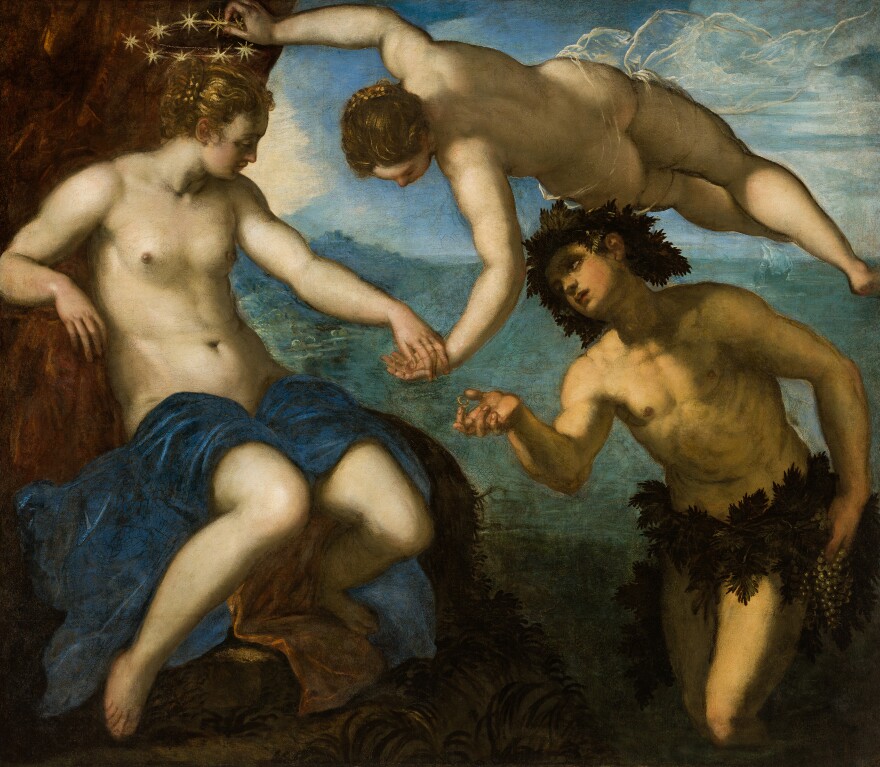Legend has it that when Jacopo Tintoretto was 12 years old, he was so good at drawing that he rattled Titian — the master artist of Venice, 30 years his senior. Young Tintoretto was an apprentice in Titian's workshop and — as the story goes — the old master gone away for several days, and when he came back he found some of Tintoretto's drawings.
"He saw these drawings and said, 'Who did this?' " explains art expert Frederick Ilchman. "The young Tintoretto was nervous, thinking he'd done a bad job ... and was going to be corrected. No, they were not bad — in fact, they were too good."
Titian felt threatened and kicked the kid out. But Tintoretto got all the lessons he needed in ambition and toughness — and went on to have a long, successful life in the art world.
That career is the focus of Tintoretto's very first U.S. retrospective, now on view at the National Gallery of Art, co-curated by Frederick Ilchman and Robert Echols. It marks the 500th anniversary of the 16th century Venetian artist's birth.
"He never saw a wall that he couldn't envision covered with a large Tintoretto," says Echols. The canvases are huge — jammed with hunky men (and some women) — writhing, and reaching, and rushing — in myths or Biblical scenes. Tintoretto painted them all over a ceiling of the Scuola Grande di San Rocco in Venice. It took ambition — and a lot of hustle.
In 1564, Tintoretto was one of four artists invited submit drawings for the grand building.
"Tintoretto doesn't have a drawing," says Ilchman. "Instead, he has pulled aside from the ceiling a big piece of cardboard to show — the fully completed oil on canvas installed in its intended position."
But wait, there's more: Tintoretto announces it's a donation, knowing full well that there are regulations that stipulate all gifts — large or small — must be accepted, Ilchman explains. It worked, and Tintoretto went on to do some 60 more paintings for the place.

Tintoretto competed for work all his life. In the 16th century, the cosmopolitan city of Venice was teeming with artists who had to fight to make a living. "It was a cut-throat environment," Ilchman says. "You had to paint quickly in order to get your commissions, in order to fill them."
Over the years, Tintoretto became immensely successful. Eventually he got so many commissions he had to hire a vast number of assistants. They worked so fast that critics thought the pieces looked unfinished. And the commissions kept coming, even though Titian had tried to block them by blackballing his former apprentice. All the while, as the rivalry continued, both artists were painting their heavenly religious scenes.

But Tintoretto was putting his own spin on it. There's so much well-known "Last Supper" imagery — the apostles sitting in a row at the table, a serene Jesus in the center. Some 60 years after Leonardo da Vinci painted his famous Last Supper, Tintoretto puts the apostles in a blender and spins them around — and paints their reactions when Christ says one of them will betray him.
"Some of them are practically falling out of their chairs backwards," Echols says. "Some of them are reaching forward, gesturing towards Christ. The painting is full of action, push, and pull, and drama. And this is typical of Tintoretto: His paintings are always dynamic — full of energy and action."
They're cinematic. You can almost hear the soundtrack.
"Jean Paul Sartre the philosopher said that Tintoretto was the first film director," Echols adds.

Speed, competition and success took its toll. You can see it for yourself in two self-portraits that bookend the retrospective at the National Gallery of Art. The first self-portrait, made when he was around 28, shows an intense, almost fierce Tintoretto — with dark curly hair, mustache and beard, he's glaring at viewers, demanding that we pay attention. The exhibit ends with another self-portrait, made when he was around 70; Tintoretto's hair and beard are white, and his stare is stony.
"The impetuous, aggressive, younger artist in that early self-portrait — now the fire has really gone out of his eyes," Echols says. "He's now tired. He's had a very long career, he's been very successful, but boy, is he weary."
Several of the artworks in the retrospective are coming to the U.S. for the first time. The exhibition is on view at the National Gallery of Art in Washington, D.C., until early July.
Copyright 2021 NPR. To see more, visit https://www.npr.org.





